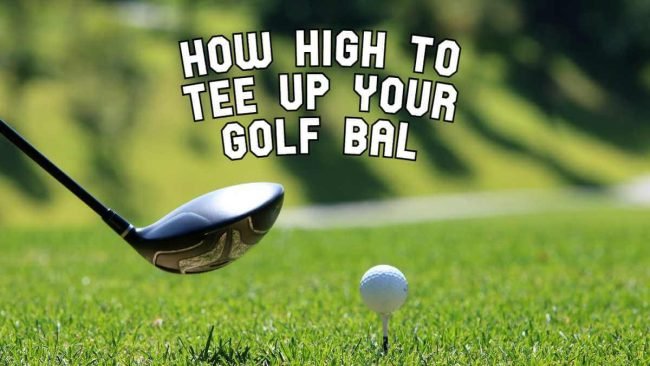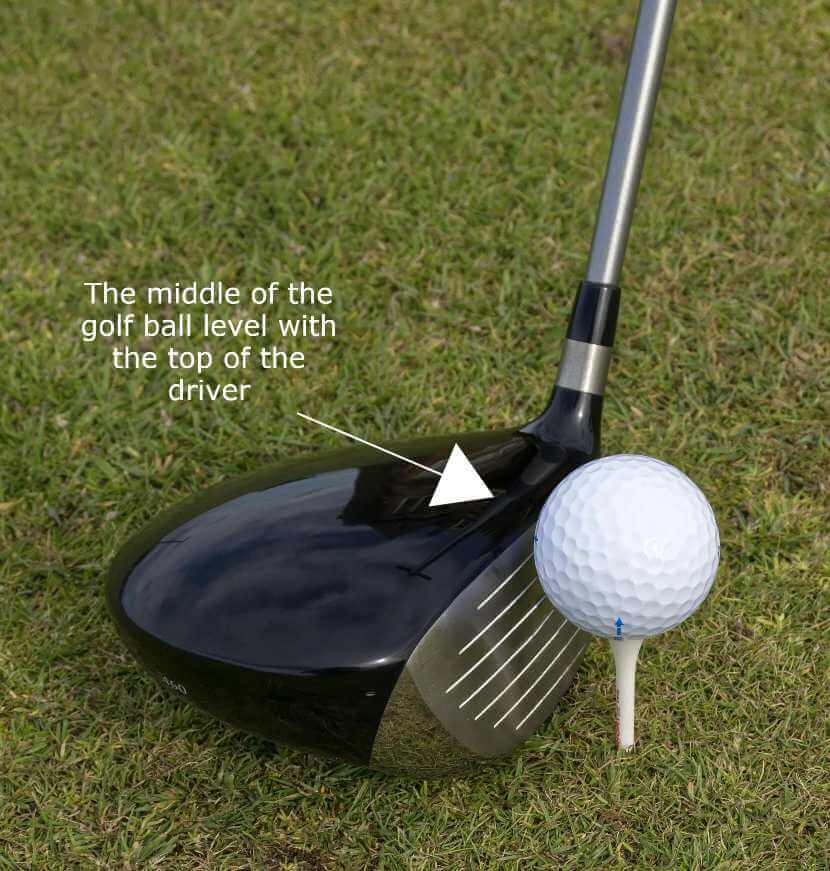
This page uses affiliate links. When you click an affiliate link, we get a small compensation at no cost to you. See Our Affiliate Policy for more info.
For every newbie who has found a long-lost love in golf, even before taking a swing with a club, one doubt that often creeps into the mind is: “How do I tee up a golf ball?”. Well, if you’re also puzzled by this, it’s safe to say that you’re at the right place right now. But, of course, we’ve all been there before; it’s just an inevitable problem – one that every professional golfer today once fought.
Next, you will be one step closer to getting your PGA tour pro card!
Interestingly, it’s not an uncommon narrative and one that tends to create a bit of confusion depending on what club you’re using – confusion that we want to help you eliminate. Know this; how you tee up a golf ball can help improve distance and accuracy off the tee. In this piece, we’ll take a closer look at the general rules that will help you tee up at the right height for each golf club in the bag – each club desires a very different approach.
How high should the tee of the golf ball be? Well, it all depends on the type of golf club you use. The wedges being the shorts, while the driver is the longest – the higher the ball should rest on the tee. The type of golf club is also crucial because they are designed differently for different types of swings. The best fairway woods and hybrids sweep into the golf ball; the drivers need to impact the teed ball on the upswing. At the same time, the iron should contact the ball on a descending path.
A bit of the tee will be above ground if you’re teeing off with an iron. For long to mid-irons (2-5i), golfers should endeavor to leave a quarter of the tee above the ground, while for players who have shorter irons and wedges (6i-wedges) players should push the tee to into the ground, thus leaving just the head of the tee showing above the turf. The ball should lie in between your legs for iron and wedges shots.
But it begs the question: “should I use a tee on par 3s?” The answer to that is ‘yes. Occasionally, you may see tour pros not using a tee for approaches to par 3’s, it’s not ideal for amateur golfers to do the same.
Depending on the different types of golf grass, your club will grip or slide through the grass even from the teebox.
Eighteen times major champion Jack Nicklaus once said, “You get 18 chances at a perfect lie – why not take them?” as “air offers less resistance than turf.” The bottom line is, try to take advantage of this and tee up the ball whenever you get the chance.

The longest golf club in the bag demands that its surface strikes the teed ball on the upswing. Hence, whenever you’re using the driver off the tee, the golf ball will proportionally be teed at its highest. However, the consensus from experts is that when the base of the ball, sits in line with the top of the driver, the golf ball is teed at its optimal spot and allows you to achieve maximum distance.
The right distance that the tee will be correctly placed is about an inch and a half above the ground, and it will be lined up on the internal section of your lead foot at the address. To achieve this height, you’ll need to use a tee that’s longer than the typical ones.
For these two tee shots, you should look to sweep the ball. To achieve this sweep, you should leave one–half to one–third of the ball above the crown of the golf club for their 3-wood with the tee sitting above the ground. For hybrids and other fairway woods – third to one-quarter of the ball above the crown is ideal to help you get that FIR in golf.
So, how high should you tee a golf ball? How high off the ground should the golf ball be? Beginners often ask these questions.
Well, the tee height often depends on the club you’ve opted for, and reiteratively, the longer the club, the higher the tee ought to be. And just as we’ve pointed out earlier, golf pro players say that the best height to tee the ball would be parallel with the top of the crown (the driver’s head). Plus. The bottom of the ball should always rest on the tee.
YES, you can tee a golf ball too high or too low! If you tee the ball too high or too low for the golf club you are playing with, then you could be placing yourself at a difficult spot to make your tee shot from – something you don’t want to do.
Pressing a stick in the ground and then placing golf on it may sound like a simple task – one that you make while playing golf, but how well it’s done determines the overall quality of the gameplay. Keep you tees safe by using the best tee holder for your golf bag.
However, it is essential to point out that there’s no one size–fit – all height for all golfers; the optimal height is different from person to person. Meaning, it all depends on the course you’re playing on and the kind of shot shape you prefer. For example, it is best to tee the golf ball slightly lower for a fade. But for a draw, it is common to tee it higher.
As a rule of thumb, when it comes to teeing for a driver, the first thing to look out for is the spot where you should be hitting the ball on the driver’s face. To get the maximum height from a driver, hit the golf ball above the mid-point of the clubface. What this does is it launches at an optimal level without the excess spins, thus maximizing the rollout.
Now that we understand the best spot to hit the ball on the driver, it is important to look at how high to tee the ball up. As a common practice, though, half of the golf ball should be above the driver when the club rests on the floor. Depending on the ball’s trajectory, you may want to play around with it. The best place to experiment with tee heights is on the range. While practicing, it’s a nice idea to play with different tee heights; the golf ball should never be completely above the driver.
You can also use the tee height to change the draw or fade pattern of your golf shots. Learn more about hitting a draw or a fade.
But what if the golf ball is too high? What happens then? Well, not to worry, this is by far one of the common mistakes made by beginners. What having the ball teed higher does is that it lets you hit upon the golf ball, thus launching it airborne.
Reiteratively, you want to ensure that you’re hitting the ball with an upward swing, though too much of this is not ideal. If you see the golf ball too high, it ultimately promotes an excessive upward swing path, which tends to produce shots that are launched on a very steep trajectory and seldom travel anywhere near as they ought to.
In the end, it pays always to pay attention to our tee height, as it’s known to be more essential than we often give credit for.
According to different tests stemmed from curiosity and questions. But, of course, even professionals make mistakes when it comes to golf. But after investing countless hours, you’ll find yourself coming up short, both figuratively and literally. So, the simple and short answer to this question is: “Yes.”
Tests carried out on different drivers were done with 120 drives hit in total. It adhered to the golden rule of a very structured model, and all the data was double and triple checked. What did they discover?
The test showed that the 1.5-inch tee yielded higher strokes-gained values and fairways-hit percentage. These factors were consistent with the 120 drives model, and it also revealed the .5-inch tee was quite shorter across the board. Golf tees can be no longer than 4″ per USGA rules.
This contributes 65 percent, while accuracy contributes 35 percent when taking values of gained driving. Meanwhile, the data also found a 1.5-inch playing tee yields 14 yards more carry distance on average compared to a .5-inch playing tee. That is a huge difference, and depending on your current circumstances, you can decide how far you drive.
Without a doubt, backspin kills distance. If you experience too much spin, the golf ball will go higher into the air and rarely hit the potential target. Looking back, backspin was 326 rpm higher on average with the .5-inch tee, so, when considering what you want.
At the end of it all, the result suggests that golfers using shorter tees could be leaving more than 15-yards on the table. Meanwhile, a shorter tee yields less consistent results. So, ensure to work out what feels more comfortable for you.
A golf tee is relatively a must-have in this sport. Almost all golfers use it. The tees help to raise the projectile as well as your strike. This is achieved by ensuring that the contact point is low on the golf ball for a more effective raise. But that’s not all; tees will also save you time and the embarrassment of miss-hits. It also raises the chances of effectively connecting with your golf ball far better than when not in use.
Tees can also have their advantages and disadvantages, click here to learn more about the best golf tees for high handicappers.
Most pro golfers do tee up very low because it gives better contact coupled with a more predictable flight and distance. Safe to say that Golf tees do make a difference. This also applies to beginners. And since most beginners don’t hit the ball very far, it’s best to start from shorter tees. For instance, let’s say you’re playing a regulation par-72 course with four sets of tees. For 18 holes, the back tees total 7,000 yards. The next set totals 6,500 yards, then 5,500 and 5,000. For beginners, either 5,000 or 5,500-yard tees are ideal. The holes will be shorter; tees will be placed where there’s no trouble between you and the green or fairway. So, if you hit a bad tee shot, odds are it will come to rest in a playable spot rather than a deep rough, bunker, or water hazard.
Once the golf ball is airborne and hits the 200 yards mark or more, you can move on to a lengthier tee box. Meanwhile, most men play from a set in the 6,000 to 6,500-yard range, while women, on the other hand, generally play from 5,000 to 5,800 yards. So, in conclusion, playing golf is hard enough, but playing the wrong tees would complicate things more.
The tee height is very important when it comes to any of your golf shots. Using a tee is giving you a free lie, so use the tee any chance you can get. You should never hit the golf ball off the ground from the tee box. Hopefully, this guide helps you going forward on knowing how high to tee your ball and starts improving your golf game greatly!